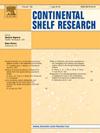Simulation and Lagrangian analysis of coastal upwelling in the northwestern East/Japan sea
IF 2.2
3区 地球科学
Q2 OCEANOGRAPHY
引用次数: 0
Abstract
The autumn monsoon coastal upwelling in the northwestern East/Japan Sea (EJS) was studied using five upwelling indices, 3D tracking of Lagrangian particles, finite-time Lyapunov exponents, and satellite data on sea surface temperature (SST) and chlorophyll-a concentration. The coastal upwelling, which had not yet been quantitatively simulated and studied in the area, begins at the end of September when northwesterly and westerly winds dominate. The simulations were conducted using the Regional Ocean Model System (ROMS) with a high horizontal resolution of 600 m. The upwelling intensity has been estimated by calculating SST difference between the coastal and offshore zones, the Ekman transport and pumping indices, sea surface height and speed of offshore surface currents. A strong upwelling event in the fall of 2017 was identified through calculations of the thermal upwelling index and other indices over the extended period from 1999 to 2019, based on model results and satellite observations. The intermittency of active and break phases during the 2017 upwelling event correlated with variations in wind direction and surface wind stress curl in the study area. The upwelling of cold bottom water to the surface was directly simulated via 3D Lagrangian particle tracking in the model velocity field. Deep-water upwelling is a dynamic process, with the distribution of upwelled particles reaching the surface layer correlating with the wind-induced upwelling index near the coastal area bounded by the 60 m isobath. Another key result of this study is the identification of transport barriers separating surface waters with different temperatures. These barriers were identified by maxima in the finite-time Lyapunov exponent, which provided insights into upwelling thermal fronts and associated transport patterns. The simulation results agreed with satellite-derived SST and chlorophyll-a data from the fall of 2017, as well as with satellite and in situ observations of coastal upwelling in the study area from other years.
东/日本海西北部沿岸上升流的模拟与拉格朗日分析
利用5种上升流指数、三维拉格朗日粒子跟踪、有限时间Lyapunov指数和海温(SST)和叶绿素-a浓度卫星资料,研究了西北东/日本海域秋季季风海岸上升流。沿海上升流开始于9月底,以西北风和西风为主,尚未对该地区进行定量模拟和研究。模拟采用区域海洋模式系统(ROMS),水平分辨率为600 m。通过计算近岸海温差、Ekman输运指数和泵送指数、海面高度和近岸海流速度估算了上升流强度。根据模式结果和卫星观测,通过计算1999年至2019年期间的热上升流指数和其他指数,确定了2017年秋季的一次强上升流事件。2017年上升流活动期和断裂期的间断性与研究区风向和地面风应力旋度的变化有关。通过模型速度场的三维拉格朗日粒子跟踪,直接模拟了底部冷水向地表上涌的过程。深水上升流是一个动力过程,上升流颗粒到达表层的分布与以60 m等深线为界的沿海地区附近的风致上升流指数相关。本研究的另一个关键结果是确定了分离不同温度地表水的运输屏障。这些障碍通过有限时间李亚普诺夫指数的最大值来识别,这为上升流热锋和相关的运输模式提供了见解。模拟结果与2017年秋季卫星获取的海表温度和叶绿素-a数据,以及其他年份研究区沿海上升流的卫星和原位观测结果一致。
本文章由计算机程序翻译,如有差异,请以英文原文为准。
求助全文
约1分钟内获得全文
求助全文
来源期刊

Continental Shelf Research
地学-海洋学
CiteScore
4.30
自引率
4.30%
发文量
136
审稿时长
6.1 months
期刊介绍:
Continental Shelf Research publishes articles dealing with the biological, chemical, geological and physical oceanography of the shallow marine environment, from coastal and estuarine waters out to the shelf break. The continental shelf is a critical environment within the land-ocean continuum, and many processes, functions and problems in the continental shelf are driven by terrestrial inputs transported through the rivers and estuaries to the coastal and continental shelf areas. Manuscripts that deal with these topics must make a clear link to the continental shelf. Examples of research areas include:
Physical sedimentology and geomorphology
Geochemistry of the coastal ocean (inorganic and organic)
Marine environment and anthropogenic effects
Interaction of physical dynamics with natural and manmade shoreline features
Benthic, phytoplankton and zooplankton ecology
Coastal water and sediment quality, and ecosystem health
Benthic-pelagic coupling (physical and biogeochemical)
Interactions between physical dynamics (waves, currents, mixing, etc.) and biogeochemical cycles
Estuarine, coastal and shelf sea modelling and process studies.
 求助内容:
求助内容: 应助结果提醒方式:
应助结果提醒方式:


